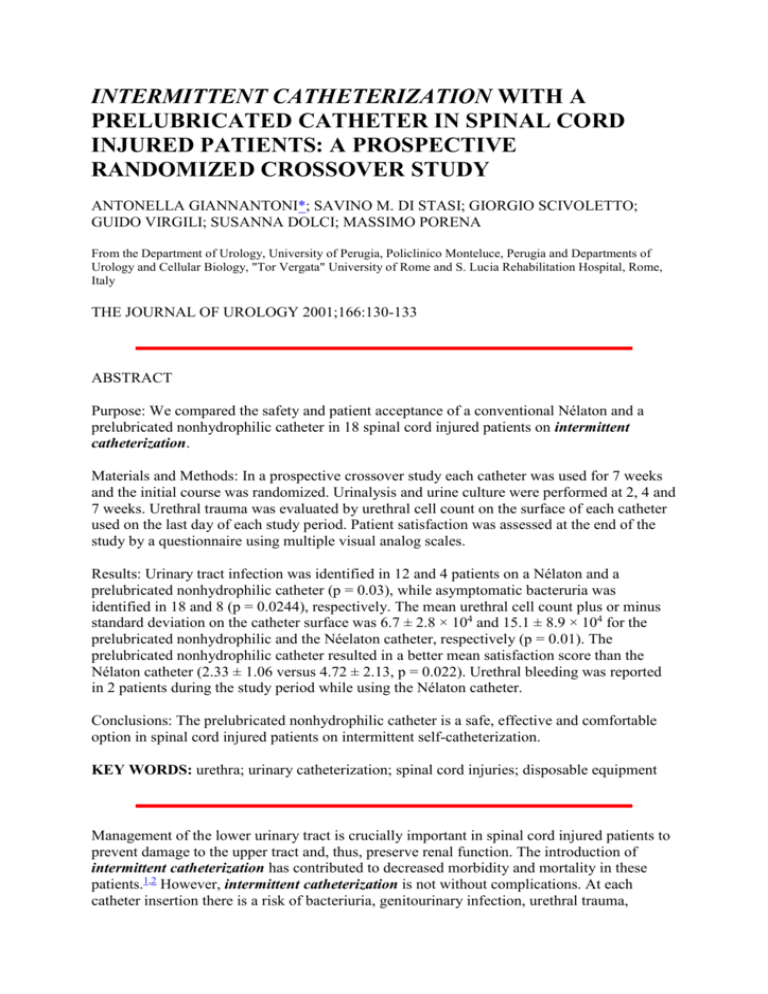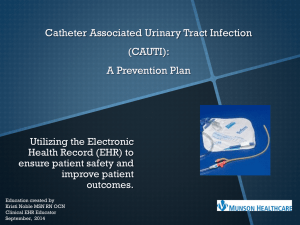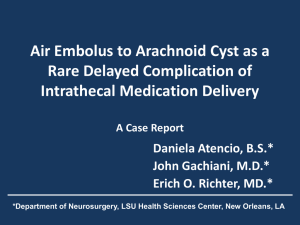
INTERMITTENT CATHETERIZATION WITH A
PRELUBRICATED CATHETER IN SPINAL CORD
INJURED PATIENTS: A PROSPECTIVE
RANDOMIZED CROSSOVER STUDY
ANTONELLA GIANNANTONI*; SAVINO M. DI STASI; GIORGIO SCIVOLETTO;
GUIDO VIRGILI; SUSANNA DOLCI; MASSIMO PORENA
From the Department of Urology, University of Perugia, Policlinico Monteluce, Perugia and Departments of
Urology and Cellular Biology, "Tor Vergata" University of Rome and S. Lucia Rehabilitation Hospital, Rome,
Italy
THE JOURNAL OF UROLOGY 2001;166:130-133
ABSTRACT
Purpose: We compared the safety and patient acceptance of a conventional Nélaton and a
prelubricated nonhydrophilic catheter in 18 spinal cord injured patients on intermittent
catheterization.
Materials and Methods: In a prospective crossover study each catheter was used for 7 weeks
and the initial course was randomized. Urinalysis and urine culture were performed at 2, 4 and
7 weeks. Urethral trauma was evaluated by urethral cell count on the surface of each catheter
used on the last day of each study period. Patient satisfaction was assessed at the end of the
study by a questionnaire using multiple visual analog scales.
Results: Urinary tract infection was identified in 12 and 4 patients on a Nélaton and a
prelubricated nonhydrophilic catheter (p = 0.03), while asymptomatic bacteruria was
identified in 18 and 8 (p = 0.0244), respectively. The mean urethral cell count plus or minus
standard deviation on the catheter surface was 6.7 ± 2.8 × 104 and 15.1 ± 8.9 × 104 for the
prelubricated nonhydrophilic and the Néelaton catheter, respectively (p = 0.01). The
prelubricated nonhydrophilic catheter resulted in a better mean satisfaction score than the
Nélaton catheter (2.33 ± 1.06 versus 4.72 ± 2.13, p = 0.022). Urethral bleeding was reported
in 2 patients during the study period while using the Nélaton catheter.
Conclusions: The prelubricated nonhydrophilic catheter is a safe, effective and comfortable
option in spinal cord injured patients on intermittent self-catheterization.
KEY WORDS: urethra; urinary catheterization; spinal cord injuries; disposable equipment
Management of the lower urinary tract is crucially important in spinal cord injured patients to
prevent damage to the upper tract and, thus, preserve renal function. The introduction of
intermittent catheterization has contributed to decreased morbidity and mortality in these
patients.1,2 However, intermittent catheterization is not without complications. At each
catheter insertion there is a risk of bacteriuria, genitourinary infection, urethral trauma,
bleeding and false passage.3-6 Stone formation, urethral stricture, urethral diverticula and
posterior bladder neck ledge irritation are also related to intermittent catheterization.6-8
Prelubricated hydrophilic catheters induce significantly less urethral inflammation and
trauma9 but patients may have problems with catheter withdrawal, difficult manipulation, and
the availability and use of sterile water to lubricate the catheter.10 Recently a prelubricated
nonhydrophilic catheter has been proposed for intermittent catheterization. We compared
patient acceptance and safety related to the use of the conventional Nélaton catheter and the
prelubricated nonhydrophilic catheter in spinal cord injured patients on intermittent
catheterization.
MATERIALS AND METHODS
Two female and 16 male hospitalized spinal cord injured patients with a mean age plus or
minus standard deviation of 38.2 ± 16.4 years and mean disease duration of 37.4 ± 13.6 days
were enrolled in our study. Table 1 lists clinical features and American Spinal Injury
Association impairment.11 All patients were informed about the scientific nature of the study
and provided written consent.
Table 1. Patient demographics
The Istantcath prelubricated nonhydrophilic catheter (Hollister, Libertyville, Illinois) is a 10Fr
silicone coated catheter prelubricated with gliceril polymethacrylate and propylene glycol gel.
The prelubricated nonhydrophilic catheter has a split introducer to guide it into the urethra,
which allows a no touch technique and has especially designed drainage eyes to decrease
urethral trauma (fig. 1). Sterile, single use, 10Fr polyvinyl chloride, silicon coated Orlycatnel
Nélaton catheters (Orly General Supply s.a.s, Milan, Italy) were lubricated by the patient
using a gel.
Fig. 1. Catheters and catheterization techniques. A, prelubricated
nonhydrophilic catheter. B, Nélaton catheter. C, split introducer of
prelubricated nonhydrophilic catheter. D, catheterization with Nélaton
catheter. E, no touch technique with prelubricated nonhydrophilic catheter.
Baseline evaluation included history, physical examination, serum chemistry studies,
urinalysis, urine culture, and imaging of the urinary tract by ultrasound, excretory urography
and cystourethrography. Urodynamic assessment followed International Continence Society
standards.12 Urinary tract infection was treated and patients were free of infection at the
beginning of the study.
All patients were transferred from the intensive care unit with a catheter indwelling. They
underwent progressive conversion to intermittent self-catheterization and were trained to
perform this technique independently. The initial application of a prelubricated
nonhydrophilic or Nélaton catheter was randomly determined and at the end of 7 weeks
patients crossed over to the alternate catheter (fig. 2). Intermittent catheterization was
performed every 5 hours. The study was double-blind since patients realized that there were 2
different catheters but they did not identify them. One of us (G. S.) organized the
randomization and another of us (A. G.) who evaluated the results was blinded to the details
of randomization. At the end of each study period patients underwent ultrasound of the
urinary tract and cystourethrography as indicated. The incidence of urethral complications
was recorded.
Fig. 2. Outline of study. SCI, spinal cord injury. PNCat, prelubricated
nonhydrophilic catheter. VAS, visual analog scale.
Urinalysis and urine culture were performed 2, 4 and 7 weeks after the commencement of
each study period. Symptomatic urinary tract infection was defined as cloudy and odorous
urine, onset of urinary incontinence, increased spasticity, autonomic dysreflexia, increased
sweating and malaise or a sense of unease associated with pyuria and significant bacteriuria.13
Asymptomatic bacteruria was defined as uropathogenic colonization of the urinary tract
without symptoms of infection.13
On the last day of each study period urethral wall trauma was evaluated by counting the cells
on the catheter surfaces.14,15 After each catheterization the catheters were divided into 5 cm.
sections and dipped in 30 ml. phosphate buffered saline (PBS) for 15 minutes in 50 ml.
Falcon tubes. During this time the tubes were shaken gently every 5 minutes to facilitate cell
release from the catheter sections. Freshly prepared paraformaldehyde (7 ml., 10% dissolved
in PBS) and 3 ml. PBS were then added to each tube for a final concentration of 2%
paraformaldehyde. The cell suspensions were incubated at room temperature for 15 minutes.
The catheter sections were removed and the cell suspension was centrifuged at 3,000 ×
gravity for 10 minutes. The pellet was resuspended in 3 ml. 2% paraformaldehyde in PBS and
gently pipetted up and down 30 times to avoid the formation of cell clumps. Aliquots (15 l.)
of fixed cells from each catheter were counted in a hemocytometric chamber at least 3 times
to reach 2 × 103 cells per sample. The counts obtained were divided by the times required to
attain 2 × 103 cells. The resulting cell numbers were then multiplied by the total volume of 3
ml. in which cells were resuspended to determine the total number of cells. Each type of
catheter from each patient were analyzed at least 3 times. At the end of each study period
patients were given a questionnaire regarding specific characteristics about catheter use. A
visual analog scale was used to evaluate patient satisfaction.16 Descriptive values are
expressed as the mean plus or minus standard deviation for urinary infection and
asymptomatic bacteruria, urethral cell number and visual analog scale scores. Comparisons of
data were assessed by the Student t test for independent measures and comparisons of rates
were done by the chi-square test with differences considered significant at p <0.05.
RESULTS
A total of 13 patients had upper motor neuron lesions with detrusor hyperreflexia, including 9
with detrusor-sphincter dyssynergia, and 5 had lower neural lesions with detrusor areflexia.
No patient had any impairment of renal function or upper and lower urinary tract
abnormalities. A total of 54 urinalyses and urine cultures were performed during each study
period (table 2). A symptomatic urinary tract infection was evident in 12 (22.2%) and 4
(7.4%) patients on the Nélaton and prelubricated nonhydrophilic catheters, respectively (p =
0.03). We identified 18 (33.3%) and 8 (14.8%) episodes of asymptomatic bacteruria in
patients on the Nélaton and prelubricated nonhydrophilic catheter regimens, respectively (p =
0.0244). Escherichia coli, Staphylococcus aureus and Pseudomonas aeruginosa were the most
common bacteria.
Table 2. Bacteriology and urethral cell count results in 54
patients
For urethral trauma evaluation urethral cell counts performed on 90 Nélaton and 90
prelubricated nonhydrophilic catheter surfaces showed a mean of 15.1 ± 8.9 × 104 and 6.7 ±
2.8 × 104 cells, respectively (p = 0.01). Catheterization performed by patients or by hospital
personnel in 3 had no observable effect. No urethral complications were observed in patients
on prelubricated nonhydrophilic catheterization but 2 (11%) using the Nélaton catheter
reported urethral bleeding.
The mean visual analog scale score was significantly better with the prelubricated
nonhydrophilic than with the Nélaton catheter (table 3). One patient with an incomplete C5
lesion and 2 with complete C7 lesions who required assistance to perform intermittent
catheterization with the Nélaton catheter became independent with the prelubricated
nonhydrophilic catheter.
Table 3. Visual analog scale scores
DISCUSSION
Since its introduction by Guttmann and Frankel,17 intermittent catheterization has
dramatically changed the management of neurogenic bladder and enhanced the long-term
survival of spinal cord injured patients. Despite advances in medical treatment, such as the
availability of more antibiotics and better catheter materials, individuals with spinal cord
injury who perform intermittent catheterization continue to have problems with urinary tract
infection and traumatic complications.13 Urinary infections are the most common
complication, developing in 31% to 83% of patients on intermittent catheterization.18
Perrouin-Verbe et al observed a lower rate of urinary tract infection (28%) and asymptomatic
bacteruria (60%) for 2 years after the acute phase of spinal cord injury.7 They also reported
epididymitis and urethral stricture rates of 10% and 5.3%, respectively, which increased with
the numbers of years on clean intermittent catheterization. Wyndaele and Maes reported
chronic or recurrent urinary tract infection in 42% of patients on intermittent catheterization
at a mean followup of 7 years.6 The incidence of nosocomial urinary tract infections in spinal
cord injured patients is not well known but it is probably the most common medical
complication during initial rehabilitation after spinal cord injury.13 Although intermittent
catheterization decreases the incidence of urinary tract infection, about two-thirds of patients
thus maintained have 1 or more episodes of bacteruria.3 Many types of catheters have been
used to prevent lower urinary tract complications related to repeat catheter introduction with
mixed results.9
We compared patient acceptance and safety related to the use of a conventional and a
prelubricated nonhydrophilic catheter. Our results show a significant decrease in the incidence
of symptomatic urinary tract infections and asymptomatic bacteruria in patients using the
prelubricated nonhydrophilic catheter. These findings may be related to the functional
properties of the catheter. It does not require additional water or gel and has a split introducer
that enables no touch catheterization. The split helps to spread the gel evenly on the catheter
as it is inserted. By pinching and/or squeezing the princer mechanism on the split introducer a
patient has good control when guiding the catheter into the urethra. Furthermore, the catheter
has especially designed drainage eyes to decrease urethral trauma to a minimum. The number
of catheterizations are reduced and the simple technique helps to maintain sterility. Although
the prelubricated nonhydrophilic catheter is more expensive than the Nélaton and similar,
readily available catheters, in our experience its use has considerably decreased the costs
associated with antibiotic therapy.
Repeat catheterization causes mechanical damage to the urethral wall and local trauma
induces urethritis, cystitis and other complications.6,13 Recent studies have shown that
decreased friction between the catheter and urethral epithelium decreases such complications
during long-term followup.14,15 Vaidyanathan et al studied the degree of urethral inflammation
in patients on intermittent self-catheterization by urethral cytology.14 They observed that the
urethral inflammatory response to repeat catheterization with a hydrophilic catheter was
significantly less than when using a plastic lubricated catheter.14 Biering-Sørensen et al
counted the number of cells on the surface of 2 low friction catheters and did not note
significant differences in urethral trauma.15 They also noted absent inflammation cells. It has
been reported that patients who use hydrophilic catheters do as well as those using
conventional catheters9 but to our knowledge there are no controlled studies comparing
hydrophilic and prelubricated nonhydrophilic catheters. Our cell count data on catheter
surfaces showed a significant decrease in the number of cells on the prelubricated
nonhydrophilic catheter, which indicates a 2-fold mean decrease in urethral trauma. None of
our patients reported any urethral complications during the study, whereas 2 using the Nélaton
catheter noticed urethral bleeding. All patients are being closely monitored to assess whether
these promising laboratory results translate into a significant clinical correlation.
The results of patient acceptance show that prelubricated nonhydrophilic catheterization is
easier than Nélaton catheterization. Particularly patients reported advantages in catheter
insertion, extraction and comfort. Because prelubricated nonhydrophilic catheterization
requires less preparation than other techniques, it is especially useful for patients with
decreased manual dexterity. In our series 3 patients who required assistance with Nélaton
catheterization became independent and had better scores on most questions. Any increase in
autonomy is an important benefit for spinal cord injured patients. Bladder management in
patients with limited manual dexterity often involves a surgical decrease in outlet resistance
and acceptance of incontinence but it has been reported that sphincter ablative procedures do
not provide the desired result and usually impair continence.3 These procedures are especially
unsuitable for female patients with incontinence and condom catheter drainage is not a perfect
solution in male patients. Some patients with high spinal lesions and limited manual dexterity
may benefit from a more simple intermittent catheterization technique and, thus, avoid major
surgical procedures.3
CONCLUSIONS
The prelubricated nonhydrophilic catheter reduces trauma to the urethral surface, results in a
significant decrease in urinary tract infections and enables easy and comfortable
catheterization. It represents an attractive alternative to conventional catheters for the
urological rehabilitation of spinal cord injured patients.
Robert L. Stephen provided suggestions and editing, and Augusto Pace and Ingrid Malinarich provided technical
assistance.
REFERENCES
1.
Weld K. J. and Dmochowski R. R.: Effect of bladder management on urological complications in spinal
cord injured patients. J Urol, 163: 768, 2000
2. Perkash I. and Giroux J.: Clean intermittent catheterization in spinal cord injury patients: a followup
study. J Urol, 49: 1068, 1993
3. McGuire E. J. and Savastano J. A.: Long-term followup of spinal cord injury patients managed by
intermittent catheterization. J Urol, 129: 775, 1983
4. Michielsen D. P. and Wyndaele J.-J.: Management of false passages in patients practising clean
intermittent self catheterisation. Spinal Cord, 37: 201, 1999
5. Webb R. J. Lawson A. L. and Neal D. E.: Clean intermittent self-catheterisation in 172 adults. Br J
Urol, 65: 20, 1990
6. Wyndaele J.-J. and Maes D.: Clean intermittent self-catheterization: a 12-year followup. J Urol, 143:
906, 1990
7. Perrouin-Verbe B. Labat J. J. Richard I. et al: Clean intermittent catheterization from the acute period
in spinal cord injury patients. Long-term evaluation of urethral and genital tolerance. Paraplegia, 33:
619, 1995
8. Perkash I.: Long-term urologic management of the patient with spinal cord injury. Urol Clin North Am,
20: 423, 1993
9. Waller L. Jonsson O. Norlen L. et al: Clean intermittent catheterization in spinal cord injury patients:
long term follow-up of a hydrophilic low friction technique. J Urol, 153: 345, 1995
10. Wyndaele J.-J. De Ridder D. Everaert K. et al: Evaluation of the use of Urocath-Gel catheters for
intermittent self-catheterization by male patients using conventional catheter for a long time. Spinal
Cord, 38: 97, 2000
11. Ditunno J. F. Young W. Donovan W. H. et al: The international standards booklet for neurological and
functional classification of spinal cord injury: American Spinal Injury Association. Paraplegia, 32: 70,
1994
12. Stöhrer M. Goepel M. Kondo A. et al: The standardization of terminology in neurogenic lower urinary
tract dysfunction with suggestion for diagnostic procedures: International Continence Society
Standardization Committee. Neurourol Urodyn, 18: 139, 1999
13. Cardenas D. D. and Hooton T. M.: Urinary tract infection in persons with spinal cord injury. Arch Phys
Med Rehabil, 76: 272, 1995
14. Vaidyanathan S. Soni B. M. Dundas S. et al: Urethral cytology in spinal cord injury patients performing
intermittent catheterisation. Paraplegia, 32: 493, 1994
15. Biering-Sørensen F. Nielsen K. and Hansen H. V.: Urethral epithelial cells on the surface on
hydrophilic catheters after intermittent catheterization: cross-over study with two catheters. Spinal
Cord, 37: 299, 1999
16. Diokno A. C. Mitchell B. A. Nash A. J. et al: Patient satisfaction and the Lofric catheter for clean
intermittent catheterization. J Urol, 153: 349, 1995
17. Guttmann L. and Frankel H.: The value of intermittent self catheterization in the early management of
traumatic paraplegia and tetraplegia. Paraplegia, 4: 63, 1966
18. Gallien P. Nicholas B. Robineau S. et al: Influence of urinary management on urologic complications in
a cohort of spinal cord injury patients. Arch Phys Med Rehabil, 79: 1206, 1998
Accepted for publication February 16, 2001.
* Requests for reprints: Via Campodimele 79, 00189 Rome, Italy.
J Urol 2001 July;166(1):130-133
Copyright © 2001 American Urological Association, Inc. ®. All rights reserved
Published by Lippincott Williams & Wilkins










